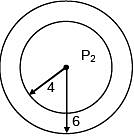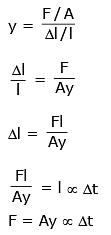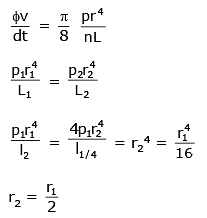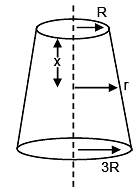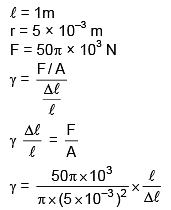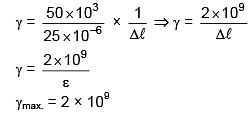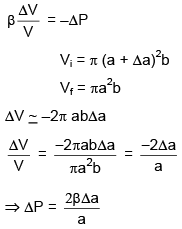Q.1. The frequency (v) of an oscillating liquid drop may depend upon radius (r) of the drop, density (ρ) of liquid and the surface tension (s) of the liquid as : v = raρbsc. The values of a, b and c respectively are (JEE Main 2023)
(1) 
(2) 
(3) 
(4) 
Ans. 3
Q.2. A Spherical ball of radius 1 mm and density 10.5 g/cc is dropped in glycerine of coefficient of viscosity 9.8 poise and density 1.5 g/cc. Viscous force on the ball when it attains constant velocity is 3696 × 10−xN. The value of x is (Given, g = 9.8 m/s2 and π = 22/7) (JEE Main 2023)
Ans. 7
Q.3. A 100 m long wire having cross-sectional area 6.25 × 10−4 m2 and Young's modulus is 1010Nm−2 is subjected to a load of 250 N, then the elongation in the wire will be: (JEE Main 2023)
(1) 4 × 10−3 m
(2) 6.25 × 10−3 m
(3) 6.25 × 10−6 m
(4) 4 × 10−4 m
Ans. (1)
Q.4. Given below are two statements: one is labelled as Assertion A and the other is labelled as Reason
Assertion A : Steel is used in the construction of buildings and bridges.
Reason R : Steel is more elastic and its elastic limit is high.
In the light of above statements, choose the most appropriate answer from the options given below (JEE Main 2023)
(1) Both A and R are correct and R is the correct explanation of A
(2) Both A and R are correct but R is NOT the correct explanation of A
(3) is correct but R is not correct
(4) is not correct but R is correct
Ans. (1)
Steel is more elastic.
Q.5. A hole is drilled in a metal sheet. At 27º C, the diameter of hole is 5 cm. When the sheet is heated to 177º C , the change in the diameter of hole is d × 10−3 cm . The value of d will be ________ if coefficient of linear expansion of the metal is 1.6 × 10−5/º C. (JEE Main 2023)
Ans. 12
ΔD = D ∝ ΔT
ΔD = 5 × 1.6 × 10-5 × (177 - 27)
ΔD = 12 × 10-3 cm
Q.6. An ideal fluid flows (laminar flow) through a pipe of non-uniform diameter. The maximum and minimum diameters of the pipes are 6.4 cm and 4.8 cm, respectively. The ratio of the minimum and the maximum velocities of fluid in this pipe is (2020)
(1) 9/16
(2)
(3) 3/4
(4) 81/256
Ans. (1)
Given that, d1 = 6.4 cm and d2 = 4.8 cm
Using continuity equation, we have A1ν1 = A1ν2
Q.7. Consider a solid sphere of radius R and mass density  The minimum density of a liquid in which it will float is (2020)
The minimum density of a liquid in which it will float is (2020)
(1)
(2)
(3)
(4)
Ans. (3)
We know that object float on liquid when its mass is equal to liquid, or force due to weight is equal to buoyancy force.
For minimum density of liquid, sphere float with completely merge in liquid.
So, mass of sphere is equal to mass of liquid displaced, that is ms = ml
Given that
So,
Q.8. Two liquids of densities ρ1 and ρ2(ρ2 = 2ρ1) are filled up behind a square wall of side 10 m as shown in figure. Each liquid has a height of 5 m. The ratio of the forces due to these liquids exerted on lower part NO to that at the upper part MN is (Assume that the liquids are not mixing) (2020)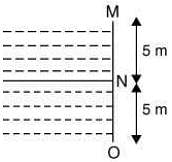
Ans. (4)
Force exert by the liquid on the wall is given by F = ρghAGiven that h1 = 5 m,h2= 10 m and ρ2 = 2ρ1 .
So, force on MN is F1 = ρ1gh1A1 ................. (1)
and, force on NO is F2 = ρ1gh2A1 +................ (2)
Since, h1 = h2
From Eqs. (1) and (2), we get
Q.9. Water flows in a horizontal tube (see figure). The pressure of water changes by 700 N/m2 between A and B where the area of cross section are 40 cm2 and 20 cm2, respectively. Find the rate of flow of water through the tube.(ρwater – 1000 kg/m3) (2020) (1) 3020 cm3/s
(1) 3020 cm3/s
(2) 2720 cm3/s
(3) 2420 cm3/s
(4) 1810 cm3/s
Ans. (2)
Given that
From equation of continuity, we have
2νA = νB ................ (1)
Using Bernoulli's theorem, we have
= 68 cm/s
Therefore, rate of flow is AAνA = 4068 = 2720cm3/S
Q.10. A small spherical droplet of density d is floating exactly half immersed in a liquid of density ρ and surface tension T. The radius of the droplet is (take note that the surface tension applies an upward force on the droplet) (2020)
(1) 
(2)
(3)
(4) r = 
Ans. (4)
Let the radius of the droplet be r.
Given condition is shown by following figureForces acted on the droplet are
(i) Buoyancy force, which act upward on the droplet and given by
(ii) Force due to surface tension, which act upward on the droplet and given by
F = T (2πr)
(iii) weight of the droplet, which act downward on the droplet and given by
At balanced point, we have B + F= W
Q.11. Speed of a transverse wave on a straight wire (mass 6.0 g, length 60 cm and area of cross-section 1.0 mm2) is 90 m/s. If the Young’s modulus of wire is 16 × 1011 N/m2, the extension of wire over its natural length is (Speed of transverse waves is given by ) (2020)
) (2020)
(1) 0.03 mm
(2) 0.02 mm
(3) 0.04 mm
(4) 0.01 mm
Ans. (1)
Given that m = 6 g, L = 60 cm, A = 1mm 2 , v = 90 m/s,Y = 16 ´1011 N/m2 Speed of transverse waves is given by
Where T is tension on wire and m is mass per unit length of wire.
Tension in wire is given by
And μ = m/L
Where Y is young’s modulus, A is area of cross section, ΔL is extension of wire, L is length of wire and m is mass.
So,
= 0.3 x 10-3 m = 0.03 mm
Q.12. A body of mass m = 10 kg is attached to one end of a wire of length 0.3 m. The maximum angular speed (in rad/s) with which it can be rotated about its other end in space station is (Breaking stress of wire = 4.8 × 107 N/m2 and area of cross-section of the wire = 10−2 cm2) is (2020)
Ans. (4)
Given that m = 10 kg, l =0.3m, Pmax = 4.8 x 107 N/m2, A = 10-2 cm2 = 10-6m2
Tension on a wire is given by T = mlω2
Breaking stress is given by
Q.13. Two steel wires having same length are suspended from a ceiling under the same load. If the ratio of their energy stored per unit volume is 1 : 4, the ratio of their diameters is (2020)
(1) √2 : 1
(2) 1 : 2
(3) 2 : 1
(4) 1 : √2
Ans. (1)
Given that
Energy stored in the stretched wire is given by
E = 1/2 x V x (stress) x (strain)
=> ε = E/V = 1/2 x (stress) x (strain) = 1/2 x
So, ε2 = 4ε1
Q.14. A rod, of length L at room temperature and uniform area of cross-section A, is made of a metal having coefficient of linear expansion α/°C. It is observed that an external compressive force F, is applied on each of its ends, prevents any change in the length of the rod, when its temperature rises by ΔT K. Young’s modulus, Y, for this metal is (2019)
(1) 
(2) 
(3) 
(4) 
Ans: (1)
...(1)
The force acts on both the end of rod. So, the length will decrease but temperature will increase.
Put this value in Eq. (1), we get
Q.15. Two masses m and m/2 are connected at the two ends of a massless rigid rod of length l. The rod is suspended by a thin wire of torsional constant k at the center of mass of the rod-mass system (see figure). Because of torsional constant k, the restoring torque is τ = kθ for angular displacement θ. If the rod is rotated by θ0 and released, the tension in it when it passes through its mean position will be (2019) (1)
(1) 
(2) 
(3) 
(4) 
Ans: (3)
If the rod is rotating through an angle θ then
whererestoring angular acceleration
Time period of S.H.M isΩ= ωθ (average velocity)
Thus,
Velocity of rotation is
Tension towards the centre is
Moment of inertia is given byPut these values in Eq. (1), we get
Q.16. A load of mass M kg is suspended from a steel wire of length 2 m and radius 1.0 mm in Searle’s apparatus experiment. The increase in length produced in the wire is 4.0 mm. Now, the load is fully immersed in a liquid of relative density 2. The relative density of the material of load is 8. The new value of increase in length of the steel wire is (2019)
(1) 3.0 mm
(2) 4.0 mm
(3) 5.0 mm
(4) zero
Ans: (1)
ρ is the relative density of material.
Initial length of steel wire, l = 1 mm
Change in length with it loaded mass (mg)Δl = 4 mm Thus, young modulus is
Dividing Eq. (2) by Eq. (1), we get
Q.17. The top of a water tank is open to air and its water level is maintained. It is giving out 0.74 m3 water per minute through a circular opening of 2 cm radius in its wall. The depth of the center of the opening from the level of water in the tank is close to (2019)
(1) 6.0 m
(2) 4.8 m
(3) 9.6 m
(4) 2.9 m
Ans: (2)
Volume of water inflow = Volume of water out flow
Q.18. Water flows into a large tank with flat bottom at the rate of 10−4 m3 s−1. Water is also leaking out of a hole of area 1 cm2 at its bottom. If the height of the water in the tank remains steady, then this height is (2019)
(1) 5.1 cm
(2) 1.7 cm
(3) 4 cm
(4) 2.9 cm
Ans: (1)
Height of water column is constant.
Flow of water in tank = Area of hole = 1 cm2 = 10−4 m
Thus, rate of water flow in the tank = rate of water out flow
Q.19. A liquid of density ρ is coming out of a hose pipe of radius a with horizontal speed v and hits a mesh. 50% of the liquid passes through the mesh unaffected. 25% loses all of its momentum and 25% comes back with the same speed. The resultant pressure on the mesh will be (2019)
(1) 
(2) 
(3) 
(4) 
Ans: (1)
Momentum per second carried by liquid per second = ρAv2
Force due to 25% which loses all its momentum
Force due to 25% which come back with same speed
Total force
Net pressure,
Q.20. A long cylindrical vessel is half filled with a liquid. When the vessel is rotated about its own vertical axis, the liquid rises up near the wall. If the radius of vessel is 5 cm and its rotational speed is 2 rotations per second, then the difference in the heights between the center and the sides, in cm, will be (2019)
(1) 2.0
(2) 0.1
(3) 0.4
(4) 1.2
Ans: (1)
Q.21. A soap bubble, blown by a mechanical pump at the mouth of a tube, increases in volume, with time, at a constant rate. The graph that correctly depicts the time dependence of pressure inside the bubble is given by (2019)
(1)
(2)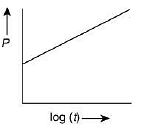
(3)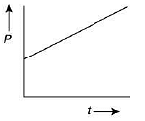
(4)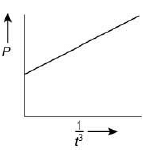
Ans: (*)
*Disputed question – either more than one option is correct or none of the options is correct.
Pressure difference in water droplet iswhere R is the radius of drop and T is temperature. Since, volume increases with time at constant rate
Q.22. A solid sphere of radius r made of a soft material of bulk modulus K is surrounded by a liquid in a cylindrical container. A massless piston of area a floats on the surface of the liquid, covering entire cross section of cylindrical container. When a mass m is placed on the surface of the piston to compress the liquid, the fractional decrement in the radius of the sphere, (dr/r) is: (2018)
(1) 
(2) 
(3) 
(4) 
Ans: (3)
Bulk Modulus,
Q.23. A thin uniform tube is bent into a circle of radius r in the vertical plane. Equal volumes of two immiscible liquids, whose densities are ρ1 and ρ2 (ρ1> ρ2), fill half the circle. The angle θ between the radius vector passing through the common interface and the vertical is: (2018)
(1) 
(2) 
(3) 
(4) 
Ans: (3)
h1ρ1 − 1 = h2ρ2
(R Cos θ + R sinθ)ρ2 = (R cosθ − R sinθ)ρ1
(ρ1 + ρ2) Sin θ = (ρ1 − ρ2 )Cosθ
Q.24. A small soap bubble of radius 4cm is trapped inside another bubble of radius 6cm without any contact. Let P2 be the pressure inside the inner bubble and P0 the pressure outside the outer bubble. Radius of another bubble with pressure difference P2 – P0 between its inside and outside would be: (2018)
(1) 2.4 cm
(2) 12 cm
(3) 4.8 cm
(4) 6 cm
Ans: (1)
r = 2.4cm
Q.25. A compressive force, F is applied at the two ends of a long thin steel rod. It is heated, simultaneously, such that its temperature increases by ΔT. The net change in its length is zero. Let l be the length of the rod, A its area of cross-section, Y its Young's modulus, and a its coefficient of linear expansion. Then, F is equal to- (2017)
(1) lA YαΔT
(2) A YαΔT
(4) l2 YαΔT
Ans: (3)
Net change in length = 0
Thermal Exp. = l ∝ Δt
Q.26. Two tubes of radii r1 and r2, and lengths l1 and l2, respectively, are connected in series and a liquid flows through each of them in stream line conditions. P1 and P2 are pressure differences across the two tubes. If P2 is 4P1 and l2 is l1/4, then the radius r2 will be equal to - (2017)
(1) 4r1
(2) r1
(3) 2r1
(4) r1/2
Ans: 4
Q.27. A uniformly tapering conical wire is made from a material of Young's modulus Y and has a normal, unextended length L. The radii, at the upper and lower ends of this conical wire , have values R and 3R, respectively, The upper end of the wire is fixed to a rigid support and a mass M is suspended from its lower and . The equilibrium extended length, of this wire, would equal (2016)



Ans: (1)
Q.28. Consider a water jar of radius R that has water filled up to height H and is kept on a stand of height h (see figure). Through a hole of radius r (r<<R) at its bottom, the water leaks out and the stream of water coming down towards the ground has a shape like a funnel as shown in the figure. If the radius of the cross- section of water stream when it hits the ground is x. Then : (2016)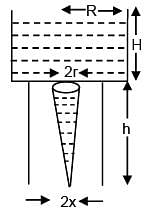




Ans: (4)
Using equation of continuity
Q.29. A thin 1m long rod has a radius of 5 mm. A force of 50 πkN is applied at one end to determine its Young's modulus. Assume that the force is exactly known. If the least count in the measurement of all lengths is 0.01 mm, which of the following statements is false ? (2016)
(1) The maximum value of Y that can be determined is 1014 N/m2
(2) ΔY/Y gets minimum contribution from the uncertainty in the length.
(3) The figure of merit is the larges for the length of the rod.
(4) ΔY/Y gets its maximum contribution from the uncertainty in strain.
Ans: (1)
Q.30. A bottle has an opening of radius a and length b. A cork of length b and radius (a + Δa) where (Δa<<a) is compressed to fit into the opening completely (See figure). If the bulk modulus of cork is B and frictional coefficient between the bottle and cork is m then the force needed to push the cork into the bottle is: (2016) (1) (2πμB b)Δa
(1) (2πμB b)Δa
(2) (πμB b)Δa
(3) (πμB b) a
(4) (4πμB b)Δa
Ans: (4)













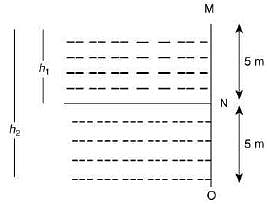 Given that h1 = 5 m,h2= 10 m and ρ2 = 2ρ1 .
Given that h1 = 5 m,h2= 10 m and ρ2 = 2ρ1 . ................ (2)
................ (2)






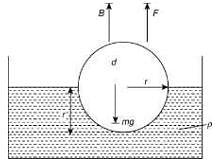 Forces acted on the droplet are
Forces acted on the droplet are


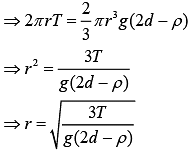












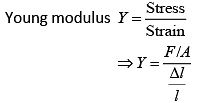
 ...(1)
...(1)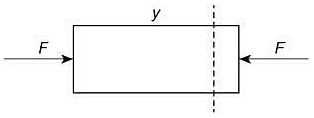 The force acts on both the end of rod. So, the length will decrease but temperature will increase.
The force acts on both the end of rod. So, the length will decrease but temperature will increase.


 restoring angular acceleration
restoring angular acceleration
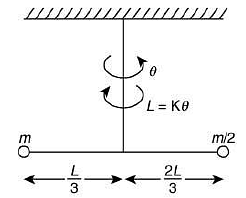 Ω= ωθ (average velocity)
Ω= ωθ (average velocity)

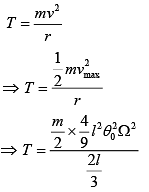

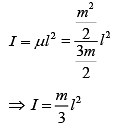
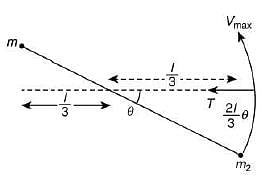 Put these values in Eq. (1), we get
Put these values in Eq. (1), we get
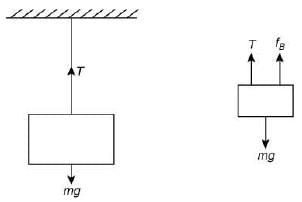 ρ is the relative density of material.
ρ is the relative density of material.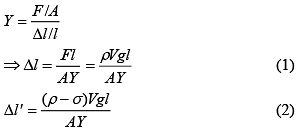
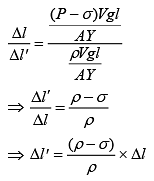

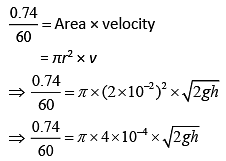
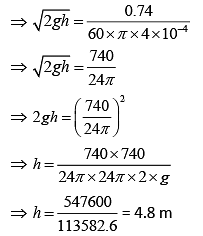
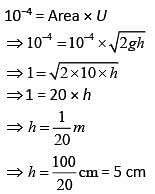




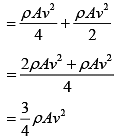


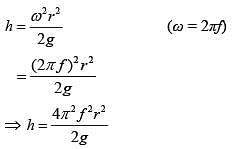


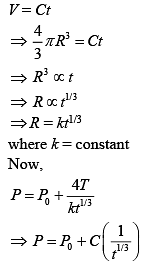


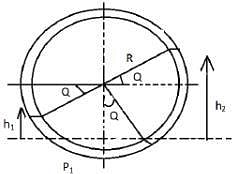 h1ρ1 − 1 = h2ρ2
h1ρ1 − 1 = h2ρ2




